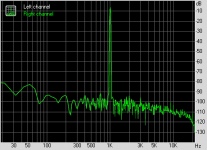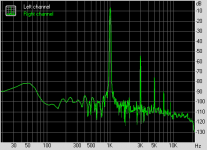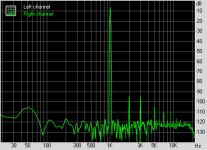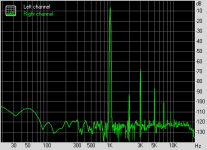Things that go screech in the night
I have been successfully using Uriah's LightSpeed clone for several months to drive a small Class D amp (with my main system using The Lighter Note).
I recently revived an old DAC that uses Sowter transformers for its I/V stage. Connected to the amp via the Lightspeed, the system emits howls and screeches that sound like a SW radio on a bad day - it is unusable. When I revert to a cheapie Valab stepped attenuator, it sounds fine.
I don't have access to a 'scope. Can anyone offer any ideas as to cause?
Thanks . . .
Dave
I have been successfully using Uriah's LightSpeed clone for several months to drive a small Class D amp (with my main system using The Lighter Note).
I recently revived an old DAC that uses Sowter transformers for its I/V stage. Connected to the amp via the Lightspeed, the system emits howls and screeches that sound like a SW radio on a bad day - it is unusable. When I revert to a cheapie Valab stepped attenuator, it sounds fine.
I don't have access to a 'scope. Can anyone offer any ideas as to cause?
Thanks . . .
Dave
Here are some additional AP curves... The other are too big to be posted. You "don't believe" I have AP measurements... You "Believe" in what your ears tell to you... Believe, don't believe... Where is science here ?...
What do you want now : the serial number of the device ? Some blood sample of the guy who build it ?
The plots you have posted just seem to be frequency response plots to me. Different attenuation levels, no indication what is what. So where is the distortion you are talking about? Are you sure you got the right data?Lot's of people in this forum know that I provide more data in combination with listening impressions than most care to do. To only look at distortion data is misleading, as I have discovered during cable testing. Additionally, setup configuration effects the results as well. We have no knowlege what are the exact circuits of comparison, circuit configuration and exact values also effect results.
I will study your plots a bit more, but it seems like scanned paper rather than direct pdf printout from AP data. So it seems the work was done not by yourself?
Are you sure you know how to read audio measurements ?The plots you have posted just seem to be frequency response plots to me. Different attenuation levels, no indication what is what. So where is the distortion you are talking about? Are you sure you got the right data?
These 2 plots are just to answer your written accusation: "I don't believe that OndesX has some AP data" : well, here are some... Then, you just are... wrong! And please notice the date of these measurements...
As explained in the post, the other documents are too big to be uploaded. But I don't think you are really interested in these scientific results, unfortunately. Whatever the results, you have your own opinion and this isn't a scientific behavior, definitely. Then, forget my own experiments. Please, make these measurements by yourself with your attenuator through an AP or any other device. I'm sure there is one not far from you... I think we may have a very interesting discussion afterwards...
I have been successfully using Uriah's LightSpeed clone for several months to drive a small Class D amp (with my main system using The Lighter Note).
I recently revived an old DAC that uses Sowter transformers for its I/V stage. Connected to the amp via the Lightspeed, the system emits howls and screeches that sound like a SW radio on a bad day - it is unusable. When I revert to a cheapie Valab stepped attenuator, it sounds fine.
I don't have access to a 'scope. Can anyone offer any ideas as to cause?
Thanks . . .
Dave
Sounds to me Dave like the Sowther is ringing it's brains out with the load (7K-12K) load that the Lightspeed presenting, where you stepped pot could be higher 50k or so.
Cheeers George
These are output measurments done by Nelson Pass.
Cheers George
Yes and I found the same result : more or less 0.25 % THD for -20 dB of attenuation.
Look here :
http://www.diyaudio.com/forums/anal...uator-new-passive-preamp-134.html#post1520950
A high value isn't ?🙂
I have some comparison of MKI and MKII LS distortion figures. Let me know if you are interested...
Last edited:
I have some comparison of MKI and MKII LS distortion figures. Let me know if you are interested...
I know your going to say the Mk1 has better distortion figures. Get your head out of these finite distortion measurements, and listen to what your ears are telling your brain.
The Mk2 kills the Mk1 in sound quality. Do you think I'm mad enough to recall 6 years ago all Mk1's to be converted to Mk2's at great expense and labour to myself, as the Mk1 was sooo easy to build hardly any matching troubles and at much less expense.
All the Mk1's converted to Mk2 status every one of the owners (approx 50) said it was a far better improvment in bass, air, body, sound staging and dynamics, not one said they wanted to go back to Mk1 status.
Cheers George
Well, if you don't have data to show your distortion measurements to support your claims, fine. But please stop this "spit war. Data can be captured and reduced to very small gif files. Many people in this forum know that I don't care about winning anything.Are you sure you know how to read audio measurements ?
These 2 plots are just to answer your written accusation: "I don't believe that OndesX has some AP data" : well, here are some... Then, you just are... wrong! And please notice the date of these measurements...
As explained in the post, the other documents are too big to be uploaded. But I don't think you are really interested in these scientific results, unfortunately. Whatever the results, you have your own opinion and this isn't a scientific behavior, definitely. Then, forget my own experiments. Please, make these measurements by yourself with your attenuator through an AP or any other device. I'm sure there is one not far from you... I think we may have a very interesting discussion afterwards...
Last edited:
Yes,
Many people using the Lightspeed vol control aren't particularly concerned about the static controlled testing results but it's still a bit dissapointing to see these figures of a device that seems to have extremely low levels of distortion in operation.
Mind you, we are quite used to many of the top performing amplifiers that test quite surprising levels of distortion, but sound very good indeed.
It is good to see so much R&D surrounding these simple (!) little variable resistors and perhaps we'll soon see the results of this flowing onto further developments and other applications.
For such a simple device, it's astonishing how well it performs and it requires a very good buffer indeed to avoid loss of quality.
Many people using the Lightspeed vol control aren't particularly concerned about the static controlled testing results but it's still a bit dissapointing to see these figures of a device that seems to have extremely low levels of distortion in operation.
Mind you, we are quite used to many of the top performing amplifiers that test quite surprising levels of distortion, but sound very good indeed.
It is good to see so much R&D surrounding these simple (!) little variable resistors and perhaps we'll soon see the results of this flowing onto further developments and other applications.
For such a simple device, it's astonishing how well it performs and it requires a very good buffer indeed to avoid loss of quality.
We must also be aware that the better fidelity, the more important device layout is. Layout can effect distortion figures among other things. Distortion is only one aspect of performance. When we listen to music, since vocals and instruments do not all have the same characteristic, distortion may change the characteristic, yet still be perceived as good reproduction; whereas other aspects not discussed can actually improve listening experience. For example, when an interconnect is connected to a normal resistor like a pot or any other type of resistor, the input impedance will look like this:
Now if the input impedance flattens out a bit like this, the sound would be significantly different.
I would be interested in seeing what kind of input impedance the LDRs have in the Lightspeed application.
An externally hosted image should be here but it was not working when we last tested it.
Now if the input impedance flattens out a bit like this, the sound would be significantly different.
An externally hosted image should be here but it was not working when we last tested it.
I would be interested in seeing what kind of input impedance the LDRs have in the Lightspeed application.
Last edited:
(((((((((WOOOO HOOO)))))))))
I put my lightspeed clone together last night and ran them through some gainclones into my headphones just to see how they did,,,,,,Need 6 ch for my active main sys.
WELL I was impressed the highs where seperated well ,midrange nice, voices not harsh,and bass was running good and tight just like I like it ,,,,so I put a POT back in one side and I could tell so,,,,MY perfect 2 eared analizer saz it's a keeper,no more pots.LOL..ALL electronic stuff drifts and changes as it ages, Right ??? so readjust when it don't sound right and go on down the road,,,,Just my nickel this time! CHEERS!
I put my lightspeed clone together last night and ran them through some gainclones into my headphones just to see how they did,,,,,,Need 6 ch for my active main sys.
WELL I was impressed the highs where seperated well ,midrange nice, voices not harsh,and bass was running good and tight just like I like it ,,,,so I put a POT back in one side and I could tell so,,,,MY perfect 2 eared analizer saz it's a keeper,no more pots.LOL..ALL electronic stuff drifts and changes as it ages, Right ??? so readjust when it don't sound right and go on down the road,,,,Just my nickel this time! CHEERS!
This is your second accusation that I not deserved ... Thus, for the second time here are distortion figures that, finally even without any AP, you could derive by YOURSELF with a good quality sound board... Firstly for the MKI (i. e. R-LDR model) and then for the MKII (i. e. the series-shunt LDR).Well, if you don't have data to show your distortion measurements to support your claims, fine. But please stop this "spit war. Data can be captured and reduced to very small gif files. Many people in this forum know that I don't care about winning anything.
Attachments
Now the MKII LS model same conditions for the measurements : who must stop "the spit war" now ?...
Attachments
Last edited:
As you can see and that it seems to be well known at least by George himself : the distortion of the MKII model is much higher than for the MKI with lot of odd harmonics ! This is probably the reason of the "detailed sound" of this setup...
Please notice the value of 0.255 % THD i. e. the same that I and other (Mr. Pass) had already reported.
Please notice the value of 0.255 % THD i. e. the same that I and other (Mr. Pass) had already reported.
Last edited:
So now you have proved to yourself, what I showed you what Nelson Pass had measured, although your measurement has added a tenth or so.
We all know that the Lightspeed Attenuator's distortion measuremnets is not as good as a resistor, but to make a volume control from a potentiometer is flawed, by it's featherweight wiper to resistive track contact, it's like having a bad loose/dirty contact on interconect rca's this is why they always sound better after a good clean and tighten up, you can't do this to a potentiometer, and they all sound different because of it.
The Lightspeed Attenuator has no such bad wiper contact, and is the closest sound to a direct connection between CD player and Poweramp. Try it for yourself, then try any other form of pasive or active preamp and you will hear the Lightspeed comes the closest to that direct conection.
Cheers George
We all know that the Lightspeed Attenuator's distortion measuremnets is not as good as a resistor, but to make a volume control from a potentiometer is flawed, by it's featherweight wiper to resistive track contact, it's like having a bad loose/dirty contact on interconect rca's this is why they always sound better after a good clean and tighten up, you can't do this to a potentiometer, and they all sound different because of it.
The Lightspeed Attenuator has no such bad wiper contact, and is the closest sound to a direct connection between CD player and Poweramp. Try it for yourself, then try any other form of pasive or active preamp and you will hear the Lightspeed comes the closest to that direct conection.
Cheers George
Now the MKII LS model same conditions for the measurements : who must stop "the spit war" now ?...
On the attached pdf, the "Testing Chain" consists of "LDRmkII/7k pot/1.5Vrms in/Att=-24dB"...why is there a 7k pot on the signal chain? Was that pot used to attenuate the 1.5Vrms input signal to about -8dB as shown on the attached screen shot? If so remove that pot and try again...
And at what R values are the series-shunt LDRs set?
This is all so much of a mute point, as I defiy anyone to hear the difference between .1% and .01% distortion in preamps. Even the great Nelson Pass makes amps that are not so good in distortion figures, but sound way better than Japanese made amps that are .00001%. Distortion figures are bandied around like the saviour of audio to the uninitated, your ears tell the truth and that is the final arbirtator.
Cheers George
Cheers George
Happy to know that you agree with Mr. Pass and me.We all know that the Lightspeed Attenuator's distortion measuremnets is not as good as a resistor,...
I think you gave a wrong explanation of a subjective fact. Me and other think that the subjective improvement of the series-shunt setup is almost only due to the odd harmonics and, moreover, we know where are coming from, these odd harmonics......The Lightspeed Attenuator has no such bad wiper contact, and is the closest sound to a direct connection between CD player and Poweramp. Try it for yourself, then try any other form of pasive or active preamp and you will hear the Lightspeed comes the closest to that direct conection.
I add two other distortion curves at 0dB showing that the MKI clearly generates more even harmonics and the MKII generates odd harmonics... And, again, we know why this is that way !... And this have nothing to do with any "contact issue"!
Attachments
Unfortunately, this is what is most often invoked by all audio Gurus when arguments lack: Trust your ears! Don't believe the measurements!... Though this mismatch was true for some ancient generation gear in which hard feedback loops were used, it is obviously untrue for correctly designed modern hardware...This is all so much of a mute point, as I defiy anyone to hear the difference between .1% and .01% distortion in preamps. Even the great Nelson Pass makes amps that are not so good in distortion figures, but sound way better than Japanese made amps that are .00001%. Distortion figures are bandied around like the saviour of audio to the uninitated, your ears tell the truth and that is the final arbirtator.
Cheers George
Thus, you simply can't claim, for obvious scientific reasons, that your ears are right when the measurements show the contrary.
Afterwards, you may decide that you prefer listen to music on an old AM radio or whatever device because you subjectively prefer this sound. But it is not acceptable to give wrong explanations which aren't based on scientific facts. Or even worse, deny evidence of scientific facts...
Last edited:
- Home
- Source & Line
- Analog Line Level
- Lightspeed Attenuator a new passive preamp



